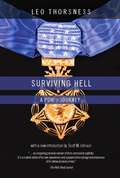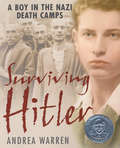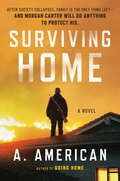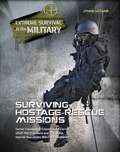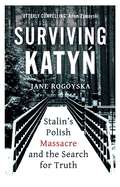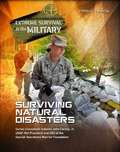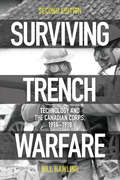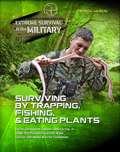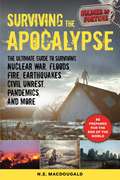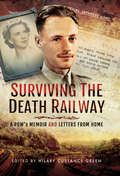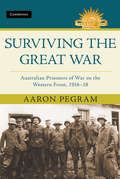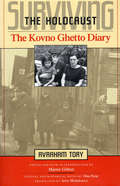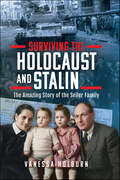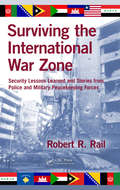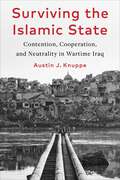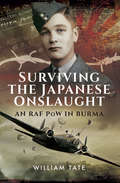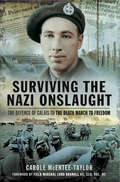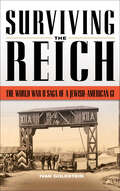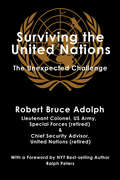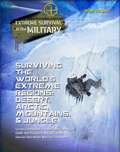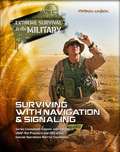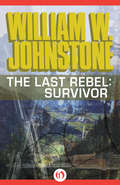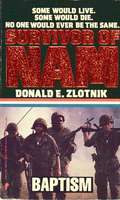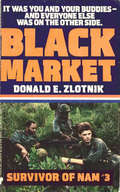- Table View
- List View
Surviving Hell
by Leo ThorsnessOn April 19, 1967, Air Force Colonel Leo Thorsness was on a mission over North Vietnam when his wingman was shot down by an enemy MiG, which then lined up for a gunnery pass on the two American pilots who had bailed out. Although his F 105 was not designed for aerial combat, Thorsness engaged the MiG and destroyed it. Spotting four more MiGs, he fought his way through a barrage of North Vietnamese SAMs to engage them too, shooting down one and driving off the others. For this action, Thorsness was awarded the Medal of Honor. But he didn't learn about it until years later-by a "tap code" coming through prison walls-because on April 30, Thorsness was shot down, captured, and transported to the Hanoi Hilton. Surviving Hell recounts a six-year captivity marked by hours of brutal torture and days of agonizing boredom. With a novelist's eye for character and detail, Thorsness describes how he and other American POWs strove to keep their humanity. Thrown into solitary confinement for refusing to bow down to his captors, for instance, he disciplined his mind by memorizing long passages of poetry that other prisoners sent him by tap code. Filled with hope and humor, Surviving Hell is an eloquent story of resistance and survival. No other book about American POWs has described so well the strategies these remarkable men used in their daily effort to maintain their dignity. With resilience and resourcefulness, they waged war by other means in the darkest days of a long captivity.
Surviving Hitler: A Boy In The Nazi Death Camps
by Andrea WarrenBlends the personal testimony of Holocaust survivor, Jack Mandelbaum, with the history of his time, documented by photos from the archives of the U. S. Holocaust Memorial Museum. What was the secret to surviving the death camps? How did you keep from dying of heartbreak in a place of broken hearts and broken bodies? "Think of it as a game, Jack," an older prisoner tells him. "Play the game right and you might outlast the Nazis. " Caught up in Hitler's Final Solution to annihilate Europe's Jews, fifteen-year-old Jack is torn from his family and thrown into the nightmarish world of the concentration camps. Despite intolerable conditions, Jack resolves not to hate his captors, and vows to see his family again. He forges friendships with other prisoners, and together they struggle to make it one more hour, one more day. But even with his strong will to live, can Jack survive the life-and-death game he is forced to play with his Nazi captors? Award-winning author Andrea Warren has crafted an unforgettable true a story of courage, friendship, family love, and a boy becoming a man in the shadow of the Third Reich.<P><P> Winner of the Sibert Honor
Surviving Home: A Novel (The Survivalist Series #2)
by A. AmericanBook 2 of The Survivalist Series No electricity. No running water. No food. No end in sight. If life as you knew it changed in an instant, would you be prepared? In A. American&’s first novel, Going Home, readers were introduced to Morgan Carter, the resourceful, tough-as-nails survivalist who embarks on a treacherous 250-mile journey across Florida following the collapse of the nation&’s power grid. Now reunited with his loving wife and daughters in this follow-up to Going Home, Morgan knows that their happiness is fleeting, as the worst is yet to come. Though for years Morgan has been diligently preparing for emergency situations, many of his neighbors are completely unready for life in this strange new world—and they&’re starting to get restless. With the help of his closest companions, Morgan fights to keeps his home secure—only to discover shocking information about the state of the nation in the process. Fans of James Wesley Rawles, William R. Forstchen's One Second After, and The End by G. Michael Hopf will revel in A. American's apocalyptic tale.
Surviving Hostage Rescue Missions
by Chris McnabWhen the lives of hostages are on the line, the soldiers of elite hostage-rescue units must act quickly and with skill. In a chaotic situation, soldiers must rely on their training, and each other, to save lives in danger. Take a look at how elite hostage-rescue units operate. Find out about the equipment that elite soldiers use and the training they must undergo. Learn about the different skills elite soldiers use, including: * fast-entry tactics through doors and windows using explosives. * building attacks using assault ladders and mountain-climbing techniques. * rescues from inside an aircraft. * negotiation techniques to calm a situation. * clues that tell when a terrorist is lying.
Surviving Katyn: Stalin's Polish Massacre and the Search for Truth
by Jane Rogoyska&‘A work of significant moral clarity and elegant precision.&’ Kirkus, starred review The Katyn Massacre of 22,000 Polish prisoners of war is a crime to which there are no witnesses. Committed in utmost secrecy in April–May 1940 by the NKVD on the direct orders of Joseph Stalin, for nearly fifty years the Soviet regime succeeded in maintaining the fiction that Katyn was a Nazi atrocity, their story unchallenged by Western governments fearful of upsetting a powerful wartime ally and Cold War adversary. Surviving Katyn explores the decades-long search for answers, focusing on the experience of those individuals with the most at stake – the few survivors of the massacre and the Polish wartime forensic investigators – whose quest for the truth in the face of an inscrutable, unknowable, and utterly ruthless enemy came at great personal cost.
Surviving Natural Disasters
by Patrick WilsonMany people experience a natural disaster at some point in their lives. Whether it's a tornado powerful enough to tear a building apart or a wildfire destroying an entire forest in a matter of hours, it's important to know how to survive in these situations. Regardless of what kind of natural disaster you might encounter, you need to be prepared. Learn some of the ways in which elite soldiers around the world deal with these terrifying events. Discover how to tell when certain disasters are about to strike, as well as how to respond during and after the disaster. This includes: * what to do when a tidal wave is approaching. * how to prepare your home for floodwaters. * what to do if a forest fire traps you. * how to shield yourself from massive lava bombs released by volcanoes. * how to survive mudslides.
Surviving Trainer & Transport Aircraft of the World: A Global Guide to Location and Types
by Don BerlinerThis final volume in the three-volume set covering more than 300 types of Surviving World War II aircraft includes the less-glamorous ones that couldn't qualify for two volumes on Fighters and Bombers. They were the ones that served absolutely vital purposes like the Army's Jeeps and trucks and the Navy's freighters and landing craft. Clearly, they made the great machine work, for without the transports and trainers and gliders and helicopters and the scout airplanes and the others, the fighters and bombers wouldn't have had fuel for their engines, nor bullets for their guns, nor food for their crews.Their pilots and navigators and radio operators and ground crews may not have had as many stories to tell of narrow escapes from massed enemy guns, but they knew that they played roles that can never be ignored. They wore the same uniforms and shed as many tears for their departed comrades. That scores of their aircraft have been lovingly restored to like-new condition and placed on display is a tribute to their sacrifices.
Surviving Trench Warfare
by Bill RawlingThe horrors of the First World War were the product of a new and unprecedented type of industrial warfare. To survive and win demanded not just new technology but the techniques to use it effectively. In Surviving Trench Warfare, Bill Rawling takes a close look at how technology and tactics came together in the Canadian Corps.Drawing on a wide range of sources, from interviews to staff reports, Rawling describes the range of new weapons that the Canadians adopted, including tanks, trench mortars, and poison gas, making it clear that the decisive factor in the war was not the new technology itself but how the Canadians responded to it. Only through intensive training, specialization, and close coordination between infantry and artillery could the Canadians overcome the deadly trinity of machine-guns, barbed wire, and artillery. Surviving Trench Warfare offers a whole new understanding of the First World War, replacing the image of a static trench war with one in which soldiers actively struggled for control over their weapons and their environment, and achieved it.Released to coincide with the centenary of the First World War, this edition includes a new introduction and afterword reflecting the latest scholarship on the conduct of the war.
Surviving by Trapping, Fishing, & Eating Plants
by Patrick WilsonElite forces are often assigned to secret missions behind enemy lines, which means they have to spend time in the wilderness. They need to be prepared to live off the land for long periods of time to keep from being detected. Therefore, an important part of elite soldiers' training is how to live in remote areas and how to get food from the plants and animals around them. Discover some of the ways in which the armed forces survive in these conditions. Learn: * how to set traps to catch small animals like weasels and rabbits. * which fish can be caught with an improvised line and bait. * which plants and fungi can be eaten. * how to spot poisonous flora and fungi.
Surviving the Apocalypse: The Ultimate Guide to Surviving Nuclear War, Floods, Fire, Earthquakes, Civil Unrest, Pandemics, and More (Soldier Of Fortune Ser.)
by N. E. MacDougaldThe Apocalypse could arrive at any moment, but with Surviving the Apocalypse, you'll be well-prepared and well-trained enough to survive any disaster—even the end of the world as we know it. Being prepared for what&’s out there is important—you have to know what to do when everything falls apart. Knowing how to survive the end of the world as we know it will prepare you for anything and everything that could possibly go wrong. From packing the proper survival kit, to surviving on the battlefield, being physically fit, and coping in the event of a socio-economic collapse, Soldier of Fortune magazine, along with N. E. MacDougald, will make sure that you&’re never caught off-guard in any situation, from natural and economic disasters to pandemics and civil unrest—even nuclear war. The purpose of this book is to provide the reader with real-world, practical information that will help them to not only survive, but thrive during a period that is likely not just another downturn in the economic cycle, but according the many experts, instead the beginning of a long downward slide, and possibly the very peak in our 10,000-year experiment of civilization. While you may not plan on being in a war zone, you never know what will happen, so the best thing to always do is be prepared. Whether it's learning how to barter and haggle, how to get the proper camouflage, or how to choose the right weapon for any situation, MacDougald and Surviving the Apocalypse will give you the training and knowledge that goes into surviving any and every dangerous situation imaginable.
Surviving the Death Railway: A POW's Memoir and Letters from Home
by Hilary Custance GreenThe ordeals of the POWs put to slave labour by their Japanese masters on the Burma Railway have been well documented yet never cease to shock. It is impossible not to be horrified and moved by their stoic courage in the face of inhuman brutality, appalling hardship and ever-present death.While Barry Custance Baker was enduring his 1000 days of captivity, his young wife Phyllis was attempting to correspond with him and the families of Barrys unit. Fortunately these moving letters have been preserved and appear, edited by their daughter Hilary, in this book along with Barrys graphic memoir written after the War. Surviving the Death Railways combination of first-hand account, correspondence and comment provide a unique insight into the long nightmare experienced by those in the Far East and at home. The result is a powerful and inspiring account of one of the most shameful chapters in the history of mankind which makes for compelling reading.
Surviving the Great War: Australian Prisoners of War on the Western Front 1916–18 (Australian Army History Series)
by Aaron PegramBetween 1916 and 1918, more than 3,800 men of the Australian Imperial Force were taken prisoner by German forces fighting on the Western Front. Australians captured in France and Belgium did not easily integrate into public narratives of Australia in the First World War and its commemorative rituals. Captivity was a story of surrender and inaction, at odds with the Anzac legend and a triumphant national memory. Soldiers captured on the Western Front endured a broad range of experiences in German captivity, yet all regarded survival as a personal triumph. Surviving the Great War is the first detailed analysis of the little-known story of Australians in German captivity in the First World War. By placing the hardships of prisoners of war in a broader social and military context, this book adds a new dimension to the national wartime experience and challenges popular representations of Australia's involvement in the First World War.
Surviving the Holocaust The Kovno Ghetto Diary: The Kovno Ghetto Diary
by Avraham ToryThis remarkable chronicle of life and death in the Jewish Ghetto of Kovno, Lithuania, incorporates Avraham Tory’s collections of official documents, Jewish Council reports, and original photographs and drawings. Gilbert’s introduction supplies the backdrop of the war in Europe, considering crucial questions of collaboration and resistance.
Surviving the Holocaust and Stalin: The Amazing Story of the Seiler Family
by Vanessa HolburnThe horrors of Auschwitz, Bergen-Belsen and labor camps were just the beginning of the struggle to survive for the Seiler family. As Hungarian Jews, they faced persecution of the very worst kind both from their own government and Nazi Germany. After liberation by the Soviets at the end of WWII they endured further punishment from the Stalinist regime concealed behind the Iron Curtain. This memoir is drawn from a recently re-discovered cache of precious family letters and exclusive interviews with Marta Seiler, who translated those letters for the first time. Marta has supplemented the account with childhood memories and original photos. The narrative is told through the voices of Marta, her mother Izabella and her father Lajos on a journey that takes us from 1935 to the present day. The reader is able to piece together the family’s personal challenges set against the backdrop of international political conflict. Exploring themes of resilience, identity and inherited trauma, by the end of the book we learn how Marta rediscovered her forbidden Jewish identity, found her place within the community and has moved toward a place of tolerance. In the tradition of oral history, Marta told her remarkable family story exclusively to journalist Vanessa Holburn. For Marta it’s important we learn the lessons of the past before they are lost for good.
Surviving the International War Zone: Security Lessons Learned and Stories from Police and Military Peacekeeping Forces
by Robert R. RailFew people are better able to describe how to survive in a war zone than those who have seen, experienced, and lived it firsthand. Presenting accounts written by military and police officers, this book offers an inside look at the lives of the officers and the local people living in the war zone environment. Covering many facets of daily life, the book examines topics such as surviving extreme temperatures and staying healthy, interacting with the indigenous population and cultural awareness, adjusting to the challenges of limited technology and resources, and protecting oneself from the imminent threat of violence that is present in all war-torn regions.
Surviving the Islamic State: Contention, Cooperation, and Neutrality in Wartime Iraq (Columbia Studies in Middle East Politics)
by Austin KnuppeHow did ordinary Iraqis survive the occupation of their communities by the Islamic State? How did they decide whether to stay or flee, to cooperate or resist? Based on an original survey from Baghdad alongside key interviews in the field, this book offers an insightful account of how Iraqis in different areas of the country responded to the rise and fall of the Islamic State.Austin J. Knuppe argues that people adopt survival repertoires—a variety of social practices, tools, organized routines, symbols, and rhetorical strategies—to navigate wartime violence and detect threats. He traces how repertoires varied among different communities over the course of the conflict. In areas insulated from insurgent control, such as cosmopolitan Baghdad, local residents had the flexibility to support coalition forces while also voicing opposition to government policies. For Iraqis in rural communities confronting insurgent control, collaboration and resistance entailed significant risks. In Sunni-majority communities in the western desert, passive acquiescence and active cooperation temporarily insulated Iraqis from insurgent victimization. For ethnic and religious minorities in the north, however, flight or resistance proved the only viable options. In many communities, local residents mobilized neighborhood self-defense groups and militias loosely aligned with coalition forces once the tides turned against the Islamic State.Beyond contributing to academic and policy debates about civilian protection during wartime, Surviving the Islamic State foregrounds everyday people’s experiences while modeling an ethical approach for conducting field research in conflict-affected communities.
Surviving the Japanese Onslaught: An RAF PoW in Burma
by William TateThese are the firsthand memoirs of the late William Albert Tate (W.O, RAF Bomber Command) framed within the factual history of his service career in the Royal Air Force between the years 1938 and 1946, penned by his son. This gripping narrative relays William's firsthand recollections of his time spent as a Japanese Prisoner of War, when he was incarcerated for two years in Rangoon Gaol, after bailing out of his Wellington over Burma. Tales of the harsh brutalities inflicted by his captors and the unsanitary conditions in which he and his fellow captives were held offer a real sense of the everyday realities experienced by Japanese Prisoners of War at this time. Jungle diseases, enforced starvation, sadistic torture tactics and the ever present threat of aerial bombardment all beset these prisoners. William and his son meditate on the legacies of enduring such trials as these in an engaging account of survival against the odds.
Surviving the Nazi Onslaught: The Defence of Calais to the Death March for Freedom
by Carole McEntee-TaylorTed Taylor, 1st Battalion, The Rifle Brigade, was sent to France in May 1940 as part of Calais Force. Initially sent to open up supply lines to the rapidly retreating BEF, they soon found themselves defending Calais against the might of the 10th Panzer Division. Outnumbered by at least three to one they held out for 4 days until they ran out of ammunition and were forced to surrender.For the next five years Ted found himself part of the huge slave labour force in Poland under the administration of Stalag XXA and Stalag XXB. Life in the POW camps bore little resemblance to the cheerful films of the 1950s with casual brutality never far from the surface. As 1945 began and the war entered its final bloody phase, the POWs dared to believe that at last they might be going home. But fate had one more cruel trick to play.As the Russians approached rapidly from the east, the terrified Germans evacuated the camps and, in temperatures below -25c, began marching the malnourished, poorly-clothed POWs back across Europe. The infamous 'death marches' to freedom across the frozen, chaotic, war ravaged landscape of Eastern Europe had begun.
Surviving the Reich: The World War II Saga of a Jewish-American GI
by Ivan GoldsteinThe memoirs of a Jewish-American soldier who is taken as a POW by the Germans and survives against all odds.Ivan Goldstein was a nineteen-year-old green-as-grass soldier heading into his first battle: the Battle of the Bulge, World War II’s fiercest engagement between the American army and Hitler’s army. A bow gunner on a Sherman tank, Private Goldstein was only hours into his first battle when his tank was hit by an enemy shell, and he was almost killed. Goldstein escapes with his life . . . only to be captured by the Germans. This could be the story of many young men from what has rightly been called “the Greatest Generation,” but Goldstein is not any young man. He is an American Jew. And when a German officer learns this, the officer says, “In the morning, take the Jew out and shoot him.” What follows is an epic story of survival in the face of seemingly insurmountable odds that is sure to engage everyone interested in the war against the Third Reich.
Surviving the United Nations: The Unexpected Challenge
by Robert B. AdolphA UN security advisor recounts his dangerous—and often contentious—time with the organization in this candid combat memoir.Robert B. Adolph was a member of the U.S. Army Special Forces before becoming a security advisor for the United Nations. Adolph was sent to some of the most dangerous places on earth in pursuit of humanitarian efforts. But sometimes his worst opponent was the institution that had sent him. He holds the distinction of having been twice promoted—and twice fired—by the U.N. In Surviving the United Nations, Adolph vividly recounts his experiences on assignment in Iraq when terrorists blew up the U.N. headquarters in Baghdad. He also describes encounters with murderous child-soldiers; blood diamonds; a double hostage-taking; an invasion by brutal guerrillas; an emergency aerial evacuation; a desperate mission to recover hundreds of prisoners; tribal gunfights and unusual kidnappings; refugee camp violence; and institutional corruption.
Surviving the World’s Extreme Regions: Desert, Arctic, Mountains, & Jungle
by Chris McnabThe world's elite soldiers can survive in the worst of conditions, whether the extreme heat of the desert or the snowy summit of a mountain. These units are trained to be experts in warfare, but their training also gives them the knowledge to live in the planet's wildest places for weeks at a time. Learn the techniques the world's finest soldiers use to survive in harsh conditions around the globe. Discover a variety of tips for surviving in barren deserts and freezing tundra. Find out how elite troops cope with danger and deprivation. You will also learn: * how to find water and food. * how to build shelters. * how to navigate. * how to perform first aid. * how to identify and avoid dangerous animals and insects.
Surviving with Navigation & Signaling
by Patrick WilsonIn any survival situation, you need to know where you are and where you're heading. If you get lost, you'll waste valuable time and energy--time that could be spent getting to safety or getting help.
Survivor
by William W. Johnstonen a book that forms a coda to William W. Johnstone's "Ashes" series, Jim LaDoux, the grandson of the legendary General Ben Raines has seen his grandfather, and the last of his family, die in the beginnings of the plague that sweeps the world, leaving many millions dead and a civilization struggling to survive and re-build after yet another in a what seems like an endless series of crippling blows.LaDoux, having stayed alone for six months in the isolated Idaho cabin built by his ancestors, realizes that he must get out and find life and hope or he will surrender to despair and death. As he starts traveling, he finds a young woman, Bev, who had been on a Believer mission and who has barely survived an attack by Rejects. The Rejects are a chaotic and violent movement of outcasts who have seen all the destruction and horror of the last few years and have formed a single belief: that there can be no God in a world such as they've lived in.As they travel together, they find love for each other and they have to deal with members of both sides of the struggle and then encounter yet a third faction, the Rebels, who believe that Ben Raines's set of beliefs is still alive and that faith, courage and firepower combined can beat back the evil that threatens to end the world.Originally conceived as the beginning of a new series, THE LAST REBEL: SURVIVOR was the only volume completed at the time of the author's death.
Survivor of Nam: Baptism - Book #1 (Survivor of Nam #1)
by Donald E. ZlotnikPrivate David Woods, newly arrived in Vietnam, faces his first bloody firefight and a deadly mission into Laos. Book 1 of Survivor of Nam.
Survivor of Nam: Black Market - Book #3 (Survivor of Nam #3)
by Donald E. ZlotnikBook 3 of this exciting Vietnam adventure series involves the military Black Market, where everything is for sale: contraband military supplies, drugs, booze, and even women. Now the time has come for the payoffs to stop and this chapter of the Black Market to be closed down for good.
